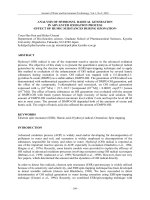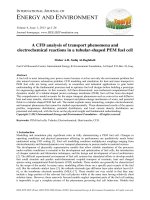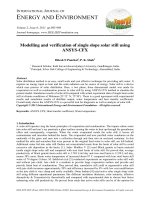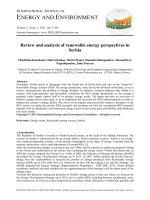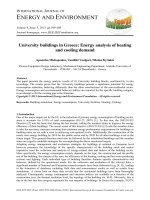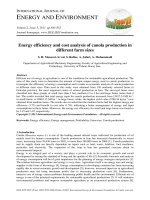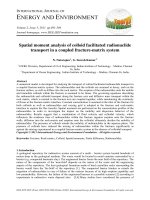Analysis of INSCSP-R7 standard problem in ENTEK BM test facility using ANSYS CFX code with calibration of parameter in boiling model
Bạn đang xem bản rút gọn của tài liệu. Xem và tải ngay bản đầy đủ của tài liệu tại đây (1.09 MB, 10 trang )
ANALYSIS OF INSCSP-R7 STANDARD PROBLEM IN ENTEK BM
TEST FACILITY USING ANSYS CFX CODE WITH CALIBRATION
OF PARAMETER IN BOILING MODEL
HOANG TAN HUNG, BUI THI HOA, HOANG MINH GIANG
Institute for Nuclear Science and Technology
Email:
Abstract: INSCSP-R7 Standard Problem based on ENTEK BM Test Facility is investigated by
RELAP5 code for prediction of averaged cross-section void fraction in vertical boiling channel of 7 m
height. This standard problem also gives a challenge in application of CFD code such as ANSYS CFX
to predict void fraction along the channel mentioned above due to: (a) only ten measured averaged
cross-section void fraction given along the channel of 7 meters and (b) CFD simulation of boiling flow
is mainly appropriate with sub cooled boiling. This study presents prediction of averaged cross-section
void fraction along the channel of INSCSP-R7 Standard Problem using ANSYS CFX with calibration
of parameter in boiling model based on experiment measured results.
Keyword: Boiling Flow, Boiling Flow, ENTEK BM, CFD, ANSYS CFX, RELAP5
I. Introduction
INSCSP-R7 Standard Problem based on ENTEK BM Test Facility is presented in the Ref.[1] together
with results from using 1D code RELAP5/MOD3.2 for calculating averaged cross-section void
fraction. As reported in the Ref [1], the calculated void fraction follow the same trend with axial
position as the experiment results. Most (i.e., 70%) of the calculated values are within the ±0.03
experiment error margin of the experiment results. In the Ref[ 2] the void fraction prediction by CTF
code is also investigated with some conclusion: (a) CTF boiling model tend to under predict void
fraction in sub cooled region where void fraction below 0.2 and tend to over predict void fraction at
nucleate boiling region where void fraction above 0.2 and (b) CTF give void fraction distribution
predictions for most all base cases are good agreement with experiment distributions with mainly
deviation within experiment measured accuracy for void fraction (0.03 of void) and the maximum
deviations with 0.1 of void between CTF prediction and experiment occur at downstream of channel
in some tests. In this study the ANSYS CFX code is used to simulation of boiling channel of INSCSPR7 Standard Problem with physical models such as (a) sub cooled boiling at a heated wall and (b)
modeling of the momentum transfer similar as presented in the Ref [3]. As known ANSYS CFX
belong to class of CFD codes and their application of boiling channel simulation still encounters a lot
of challenges due to requirement in appropriate employment from various sub models. For example,
with regard to sub cooled boiling at a heated wall It can be found many sub models related to RPI wall
boiling model such as nucleation site density, bubble departure diameter, bubble departure frequency
which are introduced in the Ref. [4] and [5]. It is also observed that no universal setting up of boiling
model for a series of test cases in specific experiment. That is why calibrations of several parameters
for simulation specific test case are presented in the Ref. [6] and [7]. Thus, with this report, by
investigation of INSCSP-R7 Standard Problem based on ENTEK BM Test Facility, two following
studied issues are presented, that include (a) calibration of bubble departure diameter and mean bubble
diameter in the bulk of water related to evaporation and condensation models are carried out under
guide of measured experiment data and (b) furthermore calibration of two above parameters in general
case without guide from measured experiment data.
II. Simulation boiling channel of ENTEK BM Test Facility
ENTEK BM facility
As mentioned in [1], Figure 1 provides a vertical and cross-section view of the test section which is
also called as Heated Release Zone (HRZ). For the cross section view, the diameters are shown in
millimeters. The HRZ contains a 7-rod bundle made by stainless steel (X18H10T). All the rods are
hollow with outer diameter of 13.5 mm, 1.25 mm wall thickness, and 7 m length. The bundle is
contained within a stainless steel pressure tube (80 mm outer diameter and 5 mm wall thickness) with
inner diameter of 49 mm and 10.5 mm wall thickness. The coolant flow area is 8.84×10-4m2 and the
hydraulic diameter is 7.84 mm. There are 20 honeycomb-type pin spacing grids along the length of the
1
HRZ, starting 30 mm from the beginning of the HRZ and repeated every 350 mm. Thus, these spacing
grids are similar to the spacers in the RBMK-1000 with a hydraulic loss coefficient of 0.4 based on
measurements.
Φ is diameter in mm
Figure 1 Test Section (Heat Release Zone) with vertical and cross section view [1]
The uncertainties of the measurements for each parameter are following for all tests are given in
Table1:
Table1. Uncertainty of input parameters
Parameters
Pressure at HRZ outlet
Coolant mass flow rate
Coolant temperature at HRZ inlet
Electrical power
Void fraction
Uncertainty
±1.5 %
±0.0018 kg/s
±1 K
±2 kW
0.03; (void is calculated rather than measured
Mesh study
Due to symmetry of Heat Release Zone geometry, only one sixth of the channel is selected to simulate
the boiling channel as illustrated in Figure 2.
Figure 2 One sixth of the Heat Release Zone geometry selected in simulation
Several meshes are studied with geometry as illustrated in Figure 3 and mesh statistics as following.
The element size (face) of corresponding Mesh 1, Mesh 2 and Mesh 3 are 5.e-004 m, 9.5e-004 m and
2
7.e-004 m. The axial number of division is 300, 350 and 200 accordingly and the total numbers of
elements for each mesh are 169500, 60550 and 61800 accordingly.
Mesh 1
Mesh 2
Mesh 3
Figure 3 Three meshes used to study
Due to only averaged void fraction in the channel is interested so that, in that terms, averaged void
fraction calculated by these three meshes give the similar results. For example, Figure 4 shows the
calculated averaged cross-section void fraction for test case T04. Thus, for further study, Mesh 2 is
selected in order to reduce calculation time.
Figure 4 Mesh comparisons for calculated averaged cross-section void fraction
III. Sensitivity study on bubble size for Bubble Departure Diameter and Mean Bubble Diameter
The Bubble Departure Diameter (bubble size at detachment) is key parameter of evaporation rate in
RPI wall boiling model that is employed in most of CFD boiling model. The evaporation rate is given
by:
̇
(
(1)
)
The model of the bubble size at detachment given by Tolubinsky and Kostanchuk (1970) for water at
different pressures and sub cooling is expressed as following:
.d
min (d
exp (−
) d
)
(2)
For the high pressure of water the parameters d
and d
is selected as 0.6mm, 45K and 1.4
mm correspondingly. The Mean Bubble Diameter
is also key parameter related to
condensation model. In the CFX, vapor is always assumed in saturated condition. So that in a
3
bulk of liquid heat is only transferred from vapor to liquid. The heat transfer per volumetric
unit, , is defined as below.
(
Where the interfacial area density
vapor to liquid
−
)
(3)
is given by
and the heat transfer coefficient from
is estimated by Nusselt number
. Thus, Mean Bubble Diameter is
inversely proportional with heat transfer coefficient from dispersed phase to continuous phase.
To close the phase transition model in the bulk bubbly flow with a mean bubble diameter , Kurul
and Podowski (1991) and also proposed to calculate the bubble diameter
locally as a linear
function of liquid sub cooling
:
(
)
(
(
)
(4)
)
In which db1 = 0.1mm at Tsub, 1 = 13.5K and db2 =2mm at Tsub,2 = -5K.
The Nusselt number can be chosen from several correlations such as Ranz Marshall Model:
(5)
In the Ref. [6] and [7] the calibration of bubble size for both Bubble Departure Diameter and Mean
Bubble Diameter are performed in order to get appropriate calculation results when simulation
DEBORA experiment. The RPI wall boing model can be expressed as following:
(
− )
(
− )
d
fn
(6)
If giving sensitivity to Bubble Departure Diameter by multiply factor S to d then it is got
repartitioning heat flux to the convection, quenching and evaporation portions with increase or
decrease of evaporation portion.
(
− )
(
− )
d
fn
(7)
Sensitivity on Bubble Departure Diameter
The Figure 5 shows the calculated averaged cross-section void fraction along the channel based on
different Bubble Departure Diameters. The different value of S were investigated such as 1.0 (default),
0.5 and 0.08.
Figure 5 Averaged cross-section void fractions with different Bubble Departure Diameters
It is observed that void with S =1 is highest and void with S=0.08 is lowest. In the case S=0.08 the
void fraction at the upstream is lower significantly in comparison with default case. In general, the
smaller S then the smaller voids fraction archived.
Sensitivity on Mean Bubble Diameter
4
The Figure 6 shows the calculated averaged cross-section void fraction along the channel based on
different Mean Bubble Diameters. The different value of S multiplied with
in equation (4) were
investigated such as 1.0 (default), 5, 15 and 17. In general, the larger S then the smaller voids fraction
archived. The significant different void fraction occurs at the downstream where the boiling regime is
most saturated boing in INSCSP-R7 Standard Problem.
Figure 6 Averaged cross-section void fractions with different Mean Bubble Diameter
Thus, it is found that by variants of different value of factor S used to multiply to d and
then the
curve of averaged cross-section void fraction along the heated channel can be controlled to be smaller
or lager based on value of factor S.
IV. Parameter calibration for averaged cross-section void based on experiment measured data
Thus, it is found that by multiplication of different factor S to d and
the sensitivity on Bubble
Departure Diameter and Mean Bubble Diameter were investigated and calibration can be based on two
this parameters to decrease or increase of averaged cross-section void fraction along the channel. The
combination from increase of Mean Bubble Diameter and decrease of Bubble Departure Diameter will
result to decrease of averaged cross-section void fraction along the channel.
Figure 7 Averaged cross-section void fractions with calibrations d
and
for test cases 3MPa
5
Figure 8 Averaged cross-section void fractions with calibrations d
and
for test cases 7MPa
Figures 7 and 8 show the curves of Averaged cross-section void fractions along the channel were
calibrated by changing d and
using multiplication factor S. As shown in Figure 7 the test case
T04 was calibrated by multiplication of 0.15 for d
and of 15 for
. With regard to test case 14 the
values of multiplication factor 0.3 and 1.4 were used to change d and
. Figure 8 shows the
values of multiplication factor of 0.2 for d
and 1.5 for
in order to calibrate test case T17 and of
0.2 for d
and 2.5 for
in order to calibrate test case T22. Table 1 shows the calibrated Departure
Diameter and Mean Bubble Diameter for several test cases with different input parameters including
pressure in two ranges: 3MPa and 7MPa. As shown in the Ref. [6] and Ref.[7] parameter calibration is
applied only for specific individual test case and it is observed from Table 1 that it could hardly derive
a correlation or a mapping between four input parameters (pressure, mass flow rate, heated power and
inlet temperature) and the Departure Diameter or Mean Bubble Diameter. So that even based in a
given database such as Table 1 it is very difficult to have a general method to estimate
and .
Up to now it can be concluded that parameter calibrations mostly bases on experiment data only.
Table 1. Calibrated Departure Diameter and Mean Bubble Diameter for several test cases
Test
Case
Pressure
(MPa)
Mass flow
rate (kg/s)
Heated
power (kW)
Inlet
Temperature
(K)
0.15
1.5
3.11
0.8816
297.6
451
0.5
10.0
3.1
0.8662
295
484
0.25
1.5
3.11
1.3301
504.3
449
0.3
1.4
3.11
1.7644
511.3
476
0.2
1.5
7.17
0.8821
302.8
496
0.2
2.5
7.32
0.8825
513.4
514
0.17
2.5
7.16
1.3243
515.8
485
0.25
1.5
7.16
0.8849
632.1
454
V. Parameter calibration for averaged cross-section void based on CTF calculation
04
05
12
14
17
22
23
25
As mention in previous paragraph, based on a specific four input parameters including pressure, mass
flow rate, heated power and inlet temperature, it could hardly introduce an appropriate
and
without experiment data. Then, it is introduced here the results from CTF calculation instead of
experiment data to be used for parameter calibration in evaporation and condensation models in
ANSYS CFX. In this study, INSCSP-R7 Standard Problem based on ENTEK BM Test Facility is also
investigated by CTF code and the results of averaged cross section void fraction given by CTF will
take role instead of experiment data. As known, CTF is verified and validated code that is widely used
in thermal hydraulic analysis in nuclear reactor so that calculation results from this code such as
average cross section void fraction is highly recommended to be used if have no experiment data.
When using CTF calculation of void fraction, in almost test cases, the saturated boiling occurs always
at downstream where CFD codes including ANSYS CFX cannot give appropriate results of void
fraction. This issue results from RPI wall boiling model developed mainly for sub cooled boing regime.
6
In CTF code, evaporation and condensation induced by thermal phase change. The heat from wall is
assumed to transfer directly to fluid by following formula:
(
)
−
(8)
Whenever heat from the wall is transferred to liquid, liquid enthalpy increases and the phase change
which is expressed via volumetric mass flow rate, Γ’’’, is calculated by subtracting condensation terms
(sub-cooled liquid and vapor terms) from evaporation terms (superheated liquid and vapor) terms:
[
(
−[
(
)
|
−
−
)
|
(
|
−
|
)
|
(
−
−
|]
)
|
−
|]
(9)
Thus, for the region of saturated boiling CTF will give liquid temperature at saturation condition. This
issue differs from CFD code due to RPI wall boing model allow quenching portion which can results
to give liquid temperature higher than saturation condition. Otherwise, ANSYS CFX can give more
appropriate results of void fraction in sub cooled region due to advantage of RPI wall boing model.
Thus, it can drive a method of parameter calibration for general case as following:
(a) Use CTF to predict void fraction of test case. Then it can determined the segment of sub
cooled boiling based on output from CTF results
(b) Partition whole heated channel into 2 parts: the first is sub cooled and the second is saturated
regions.
(c) Simulation of whole heated channel with notice that at the parameter calibration is applied
only at saturated region but not in sun cooled one.
Following the above method, it could be used both the advantages from CFD and CTF codes. For the
upstream segment of heated channel when sub cooled boiling occurs the ANSYS CFX can simulate
this phenomena based on local parameters such as
and
while CTF code with unique boiling
model as mention in formula (9) cannot simulate it appropriately. At the downstream where saturated
boiling occurs ANSYS CFX code cannot give appropriate results of averaged cross void fraction
rather than CTF code then the parameter calibration is implemented based on CTF results. Even
and
are local parameter but the calibration of them in fact is repartitioning heat transferred from
wall to water as mention in the formulas (6) and (7). Of course changing these local parameters may
affect to other local phenomena such as momentum transfer but it is here interested only in averaged
cross section void fraction so this method should be applicable.
Figure 9 Averaged cross-section void fractions with calibrations based on CTF results for test case of
3 MPa and comparison with experiment measured data
7
Figure 10 Averaged cross-section void fractions with calibrations based on CTF results for test case of
7 MPa and comparison with experiment measured data
Figures 9 and 10 show the averaged cross-section void fractions with calibrations based on CTF
results for test cases T08 (with pressure of 3MPa) and T20 (with pressure of 7 MPa). In two Figures
above the left show the curves of CTF void prediction, default ANSYS CFX void prediction and the
ANSYS CFX calibrated void prediction. Otherwise, the right show the comparisons between ANSYS
CFX calibrated void prediction and experiment measured data. It is seen that the resonable results
achieved from this method of parameter calibration.
VI. Conclusions
As mention above ANSYS CFX used to simulate boiling channel still encounters a lot of challenges
due to requirement in appropriate employment from various sub models. It is also observed that no
universal setting up of boiling model for a series of test cases in specific experiment. That is why
calibrations of several parameters for simulation specific test case are presented in several works. In
this study, It is obseved that the sensitivity on Bubble Departure Diameter and Mean Bubble Diamter
will affect much to void fraction prediction of the ANSYS CFX. Then by using multiplication factor
to change these parameters it is driven to a method for parameter calibration of boiling and
condensation models in ANSYS CFX. However, the parameter calibration is mainly based on
experiment date and is applicale for a specific single tets case only. Thus, based on a specific four
input parameters including pressure, mass flow rate, heated power and inlet temperature, it could
hardly introduce an appropriate
and
without experiment data. Then it is recommended to
divide the heated channel in two segments: upstream and downstream based on using CTF
caluculation. At the upstream where sub cooled boiling occurs the defaul model of ANSYS CFX can
be applicale. At the downstream when saturated boiling occurs the parameter calibration is
implemented based on CTF reslts will give more approprepriate results of avergaed cross section void
fraction. Thus with assistance of CTF code for parameter calibration the results from ANSYS CFX
void fraction prediction can be improved significanly.
Nomenclature
̇
Evaporation rate (kg/s)
Wall temperature (K)
Wall area fraction cover by water
Wall area fraction cover by vapor bubbles
Sub-cooled liquid interfacial area per
unit volume (m1)
Sub-cooled vapor interfacial area per unit
volume (m1)
Super-heated liquid interfacial area per
unit volume (m-1)
Super-heated vapor interfacial area per
unit volume (m-1)
Convection heat transfer coefficient
(W/m2.K)
Sub-cooled liquid interface heat transfer
coefficient (W/m2.K)
Sub-cooled vapor interface heat transfer
coefficient (W/m2.K)
Conductor surface area in mesh cell (m2)
Mesh-cell area, X normal (m2)
Evaporation heat flux (W /m 2)
Liquid heat flux (W /m 2)
Saturate temperature (K)
Bubble departure diameter (mm)
Mean bubble diameter (mm)
Gas density (kg/m3)
Cpl
Liquid specific heat, constant pressure (J/kg.K)
8
Super-heated liquid interface heat transfer
coefficient (W/m2.K)
Super-heated vapor interface heat transfer
coefficient (W/m2.K)
Liquid saturation enthalpy (J/kg)
Quenching heat transfer coefficient
(W/m2.K)
Vapor saturation enthalpy (J/kg)
Liquid enthalpy (J/kg)
Liquid temperature (K)
Near-wall liquid sub-cooling (K)
Cpv
Vapor specific heat, constant pressure (J/kg.K)
Multiply factor
Nusselt number
Prandtl number
Reynolds number
Bubble Detachment Frequency (Hz)
Wall Nucleation Site Density
References:
[1] P. L. Garner.,(2002) ―RELAP5/MOD3.2 Analysis of INSC Standard Problem INSCSP-R7: Void
Fraction Distribution over RBMK Fuel Channel Height for Experiments Performed in the ENTEK
BM Test Facility‖, United States International Nuclear Safety Center, Reactor Analysis and
Engineering Division, Argonne National Laboratory, April 2002.
[2] Hoang Minh Giang, Hoang Tan Hung, Nguyen Phu Khanh., (2015) ―Investigation of CTF void
fraction prediction by ENTEK BM experiment data‖, Nuclear Science and Technology (ISSN 18105408), Vol5, No1, 2015 PP.8 -17.
[3] Eckhard Krepper, Bostjan Koncar ˇ, Yury Egorov, (2006) ―CFD modelling of subcooled boiling—
Concept, validation and application to fuel assembly design‖, Nuclear Engineering and Design 237
(2007) 716–731.
[4] S.C.P. Cheung, S. Vahaji , G.H. Yeoh , J.Y. Tu (2014) Modeling sub cooled flow boiling in
vertical channels at low pressures – Part 1: Assessment of empirical correlations. Article in press,
International Journal of Heat and Mass Transfer xxx (2014) xxx–xxx.
[5] S.C.P. Cheung, S. Vahaji , G.H. Yeoh , J.Y. Tu, (2014) Modeling sub cooled flow boiling in
vertical channels at low pressures – Part 2: Evaluation of mechanistic approach. Article in press,
International Journal of Heat and Mass Transfer xxx (2014) xxx–xxx
[6] Eckhard Krepper, Roland Rzehak, (2016) ―CFD for subcooled flow boiling: Simulation of
DEBORA experiments‖, Nuclear Engineering and Design 241 (2011) 3851–3866.
[7] E. Krepper, R. Rzehak, C. Lifante, Th. Frank, ―CFD model of wall boiling considering the bubble
size distribution‖, NURETH15-333, The 15th International Topical Meeting on Nuclear Reactor
Thermalhydraulics, NURETH-15 Pisa, Italy, May 12-15, 2013.
9
MƠ PHỎNG BÀI TỐN CHUẨN INSCSP-R7 TRÊN THỰC NGHIỆM
ENTEK BM DỰA TRÊN HIỆU CHỈNH THAM SỐ MƠ HÌNH SƠI BẰNG
PHẦN MỀM ANSYS CFX
HOÀNG TÂN HƯNG, BÙI THỊ HOA, HOÀNG MINH GIANG
Viện Khoa học và Kỹ thuật Hạt nhân
Email:
Tóm tắt: Bài toán chuẩn INSCSP-R7 dựa trên hệ thực nghiệm ENTEK BM về dịng sơi trong
kênh thẳng đứng chiều dài 7m đã được phân tích bằng phần mềm hệ thống RELAP5 cho việc dự đốn
hệ số pha hơi trung bình dọc theo kênh dẫn. Việc sử dụng chương trình CFD như ANSYS CFX để dự
đoán hệ số pha hơi dọc theo kênh nêu trên luôn gặp phải thách thức do hai yếu tố sau: (a) chiều dài
kênh sôi lớn trong khi chỉ có mười điểm đo thực nghiệm và (b) bản thân các phần mềm CFD chỉ mô
phỏng phù hợp với trạng thái sơi dưới bão hịa (subcooled boiling). Báo cáo trình bày việc mơ phỏng
và dự đốn hệ số pha hơi trung bình dọc theo kênh bài tốn INSCSP-R7 bằng phần mềm ANSYS CFX
trên cơ sở hiệu chỉnh các tham số mơ hình sơi sao cho phù hợp với dữ liệu thực nghiệm.
Từ khóa: Dịng sơi, ENTEK BM, CFD, ANSYS CFX, RELAP5
10
